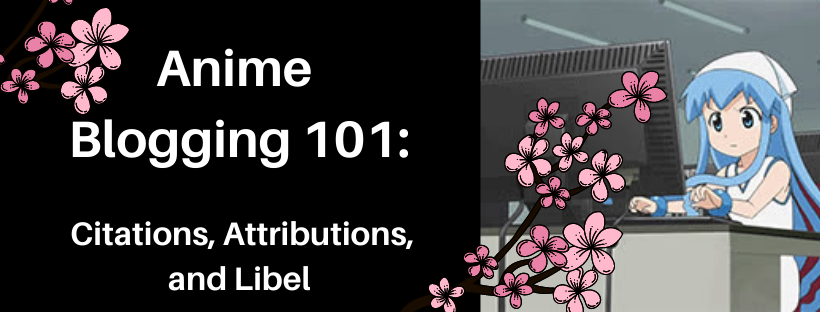Blogging requires many different considerations. First, you have to keep track of what is going on in the communities you are a part of. You have to be careful of copyright issues. This is particularly problematic for images since it is very easy to just do a fast image search, right click, and snatch the image. One top of that, it is good practice to cite your blog post’s sources. Citations are tedious and annoying, but they lend credibility to your writing.
Anyway, we are in luck! There are many tools floating around that help you with these problems. Let’s take a look at some of them.
Tracking Anime Articles

How many anime blogs do you read? It is impossible to keep track of everything in the anime and manga blogspheres. There is just too much stuff! That, and let’s be honest, most of the articles floating around are poorly written and trite. The web is flooded with half-baked opinions. Including mine! The best source for ideas is reading what other people are writing about. So what is a blogger to do?
Enter two websites: AnimeNano and AnimeShinbun.
Anime Nano
Anime Nano is an RSS based feed site. Anime bloggers submit their RSS feeds, and articles are automatically added to the post lists. Registration is free. An account lets you filter the incoming feeds to the blogs that interest you the most. I have Firefox display the main RSS feed from the website in a sidebar. This lets me constantly see what new topics and posts are trending.
Anime Nano isn’t moderated. However, I haven’t seen advertising spam yet. This also means writing quality varies widely.
AnimeShinbun
This is probably one of the best anime blogging feed sites around. The site is community moderated with strict posting rules. That means members of the community vote to approve links you submit before they appear on the main feeds. This tends to weed out poor writing, duplicate posts, and other problems blog feeds have. AnimeShinbun has temperature ratings that show how popular a particular article is.
AnimeShinbun keeps you up to date with what the anime community finds interesting each day. There is a preponderance of reviews, but that does reflect what most anime bloggers write. It also can help your blog get noticed. Just don’t spam your links. This will hurt your reputation.
Copyright Tools
Copyrights are thorny. Images are particularly problematic since most websites do not source their images. Yeah, JP is also bad about that. As I already mentioned (and I will link the copyright article again in case you missed it), I wrote a general summary of US copyright law that bloggers should understand. However, there is another way to avoid copyright hassles: public domain images.
Most images on Flickr belong to their owner or are released under Creative Commons. It is best to just assume they below to the person who made the picture. However, Flickr has a commons area that hosts a wealth of public domain and copyright free images. Institutions involved in the Commons project include the National Library of Medicine, The British Library, and other organizations. There are some cool images to be found here.
However, some of these images may not actually be public domain. Read what Flickr has to say about this (see Source):
Photographs can be difficult to analyze under copyright law, not only because laws around the world differ with respect to scope and duration of protection, but because the photographs themselves often lack credit lines, dates and other identifying information. Libraries, museums and other cultural institutions have a great deal of experience with photographs because they frequently collect, preserve, document and study them in accordance with their nonprofit missions. However, in many instances, a cultural institution will not be the rights holder under copyright law. Therefore, it can neither grant permission to others who wish to use a photograph nor provide a guarantee that the photograph is in the public domain.
So in other words, it is still up to you to determine if the image is actually free of copyrights. However, this tool does increase the likelihood of the image being copyright free. Yep, the images I used in this article are all from the service or WikiMedia Commons.
This website provides public domain and freely licensed educational media. Use of the images varies based on the original author’s criteria. As WikiMedia states:
Everyone is allowed to copy, use and modify any files here freely as long as they follow the terms specified by the author; this often means crediting the source and author(s) appropriately and releasing copies/improvements under the same freedom to others.
Like Flickr Commons, images posted on WikiMedia Commons may actually have copyrights. WikiMedia Commons also has audio, videos, and other goodies that are useful for bloggers.
New York Public Library Digital Collection
The New York Public Library has a vast collection of images and public domain images. It has a nice collection of Japanese postcards from the late 1800s and woodblock prints from the Edo period.
Citation Machine
It is a good idea to cite your sources. As I mentioned, citations make your writing more professional and lends it more authority. Citations are a headache though. They are tedious. Luckily, this being the web rather than an academic paper, few people will call you out on a citation if you forget a period. That said, it is a good habit to get it as close to being a proper citation as you can get.
Citation Machine offers some help. The web tool lets you set up citations in APA, MLA, Chicago and Turabian. Select the citation you want and then you can search WorldCat for the book you want to cite. The tool also lets you select magazines and other types of information. Fill out the form with the article or book’s information and you are golden! The help links will tell you what each field expects and where to find the information. It is pretty sweet.
Writing Tools

Sometimes our brains fly ahead of our fingers. Blog posts sometimes look like a book going through a blender. Nothing beats good old fashioned hand editing and proofreading, but sometimes we need a little help. English grammar is a jungle of rules and contradictions. To use the Oxford comma or not to use the Oxford comma? That is the question.
What is an Oxford comma anyway? (It is the comma used in a series of words that need a conjunction: apples, oranges, and neko! The red comma is the Oxford comma.)
Well, the Web comes to the rescue. Well, not to the rescue, but it does offer some help. Automated tools, as any user of Microsoft Word knows, are not perfect.
PaperRater
PaperRater offers a free grammar and spell check tool that also offers word suggestions. The tool makes suggestions within your text, and also rates your use of vocabulary. Like all automatic rating software, you shouldn’t put too much weight to this evaluation. PaperRater is designed for, well, papers. It lets you select your target education level and the type of paper. It also can check your citations. It is a pretty nifty tool. If you have doubts on your grammar and proofreading skills, this tool may help. There is a paid version that gets rid of the website’s advertising and lets you submit longer papers. It isn’t necessary for bloggers like us.
Hemingway App
Hemingway App is a nifty application that checks your writing’s readability. It looks for sentence complexity and the use of passive voice. Passive voice, for those of you who are rusty on grammar, is a static sentence structure. It states that sometime is rather than show that something acting. Words like is, had, have, and -ing verbs are passive.
There is a paid desktop version of the app. The free version has some limitations, but it is still helpful in pointing out your bad habits. The application gives you a readability score. The app highlights difficult sentences, adverbs, and passive voice using a color key.
The application, in case you are wondering, is named after Ernest Hemingway. The American author is known for his short sentences and clear writing style. Clarity is important in blogging. JP sometimes gets muddled. This is especially true when we lapse into academic speak.
So there you have it! A collection of tools that should be useful for your blog writing. Heck, many of these tools are useful for essay writing. It is important for all of us to take the time to improve the quality of the Web. The web is full of trash writing, spam, and nonsense. Clean up starts with each of us. Writing clearly, intelligently, and with good, researched information improves the quality of the Web. At the least, your blog will be an oasis for web surfers riding the flood of junk information.




Indeed a great list. 😀
I am using some of these blogging tools and these tools always make my work easy and time consuming.
I use these blogging tools:
1. WordPress as CMS
2. Grammarly as proof reading tool
3. Flickr for high quality images
4. Google Keyword Planner
5. Google Webmaster Tools
6. Google Analytics
7. Long Tail Pro
8. HostGator Hosting
These are some blogging tools and resources which I am using on my blog and I am happy with these tools.
Either way, Thanks for sharing such a wonderful post with us. 😀
Bloggers have many options for useful tools nowadays. WordPress is an excellent CMS, and I share your use of Google Webmaster Tools and Analytics. I used to worry about keywords and SEO, but I found my time is better used with research.